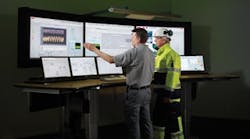Check out ControlGlobal.com on Google+ and Keith Larson's Google+ profile.
The control room is no less than the nerve center of process performance, the place where daily decision-making affects corporate goals of operational excellence and a high return on plant assets. So why are many control centers and operator stations designed without respect to human factors? Indeed, incorrectly planned environments intended for around-the-clock use often are depressing, unwelcoming and uncomfortable at best—and at worst a recipe for operator fatigue and boredom.Conversely, disciplined attention to human factors and ergonomics in the control room can not only boost operator effectiveness, but signal to operations staff that they are respected contributors to the organization's goals. From the process graphics they view to the ways they communicate, operators expect—and deserve—to work in an environment that acknowledges this important role, and to be equipped with the tools they need to help the organization succeed. Attention to human factors in the control room can also help attract and retain new operators, reduce turn-over and even reduce workplace health issues.
ABB has a long history of involvement with human factors and ergonomic research, and its operator effectiveness approach is designed to deliver the best and most efficient control room environment possible today. By tackling not only the operator console and control room, but the entire operations center as well, ABB is working to enable greater productivity and new levels of collaboration in plants around the world.
The cornerstone of ABB's operator effectiveness offering is its Extended Operator Workplace (EOW). Developed in conjunction with ergonomics specialist CGM, the EOW is essentially an ergonomic visualization and communication solution for operators. From the ground up, it's designed to support pro-active responsiveness, interaction and collaboration.
At the Operations Console
Just as process conditions are carefully controlled and manipulated to achieve desired outcomes, operator station conditions must be adjustable to the preferences of individual operators, and even be automatically changed in response to a process situation.
As well as smaller, personal screens, EOW operators have at their disposal large-screen overview displays designed to complement traditional back-wall display technologies. By not having to share a large display with others, operators can arrange graphics for an optimal view of the process under their control. Meanwhile, operators can readily show any information relevant to any situation to anyone they choose — either in the control room or elsewhere. This facilitates collaborative problem solving by ensuring that key personnel groups always have a clear view of what is happening, and can see what needs to be done.
In a recent survey sponsored by ABB, Control readers were asked what ergonomic features currently are used in their plants' control room operator stations. Adjustable seating and configurable navigational keys were the only features used by a majority of respondents; climate controls and directional sound were used by a relative few.
* Including configurable short-cut keys, single keyboards for multi-screen displays, etc.
See "The State of Operator Effectiveness" for more details on survey respondent demographics.
The Advanced Operator Keyboard features hotkeys, digitally configured and labeled, for easily navigating among three or four different monitor clients. The motorized overview unit includes a directional sound system as well as a high frequency dimmable lighting system. The console has a live video camera system with speaker system for public announcements. Micro ventilation capabilities allow each operator to personally adjust ambient temperature conditions. Further, the EOW can include context-sensitive lighting sidewalls and ceiling tiles that dynamically reflect plant conditions: when ambient lighting shifts from green to red, non-essential personnel get the hint that the process needs the operator's undivided attention.
In the Extended Control Room
In ABB's view of plant operations, the whole control infrastructure should enhance operator performance via improved information flow and collaboration. The company's attention to operator well-being and efficiency thus extends beyond the control room walls to encompass the entire operations center.
The larger operations center layout should include a dedicated operations space that is free from distractions. A separate area for visitors should be provided so that non-essential personnel are kept out of the control area. A dedicated collaboration space should be provided for meetings and group troubleshooting, with A/V tied to control center visualization. Further, a relaxation area should be provided to help operators not actively engaged in operational duties to recharge without distracting on-duty personnel.
Control readers rank the consolidation of systems in centralized control rooms as well as remote access to operations data as the most effective tools for enhancing collaboration. Large back-wall displays and video conferencing are viewed as less effective.
The System 800xA/EOW combination can even save on control room real estate. Because operators always have personalized, interactive displays close at hand, the need for huge, full-wall screens can be reduced or eliminated. Directional sound, which targets only the operator at a specific console, means that they can sit closer to one another yet still enjoy a quiet workplace free from distraction. Compared with many older control room solutions, floor space requirements can be cut by a third or more. In any case, control center designers need to consider how their decisions impact operator performance early in the overall process.






